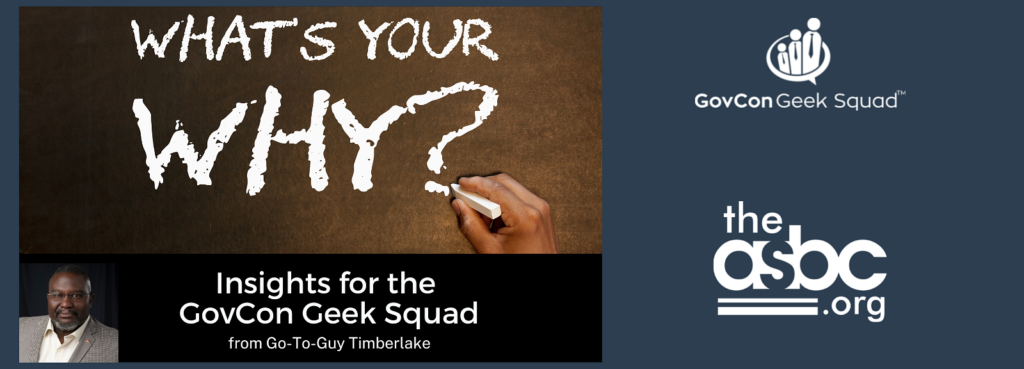Knowing the Why

I smiled when I read a LinkedIn post by my friend Anna Urman the other day. It was in reference to a conversation she had with an Industry colleague about vendor market research. Loosely, the post said, ‘It’s more than just number crunching and reviewing historical contract data, it’s as much about agency goals and objectives.’ In her comments, Anna cited a mutual colleague, Glenn Robinson, who, like me, is among the practitioners bringing a balanced approach to Business Development. That balance is not only ensuring quality engagement and execution throughout the Business Development Life Cycle, but also ensuring companies consume WHY an agency is buying and not just WHAT, WHEN and HOW they are buying. In the Ethical Stalking for Government Contractors® paradigm, we call this “Knowing the Why.”
The use of the 5W’s in federal contracting is imbalanced, at best. What, When and Who get a ton of mileage, How does to, specifically related to the procurement method, Where is an afterthought and Why doesn’t even tip the scales. But they should and knowing the why, honestly, is not difficult. Our dear old Uncle Sam makes it pretty easy for us to understand WHY they pursue certain outcomes and methodologies. They are somewhat obligated to do so seeing they are the largest public company in the world. Let’s talk about the resources they make available, that are unknown, misunderstood or just plain ignored by many in Industry.
Since we’re looking at the U.S. Government as a company, let’s start with their business plan. It’s not one document but a host of documents that include department-level charters (think DoD, HHS and USDA missions, for this) that all roll up to the agenda of the current CEO. The CEO is the sitting POTUS and the agenda is actually the President’s Management Agenda or PMA. Each of his business unit executives (think secretaries and administrators of Commerce and GSA) must adapt their organizational charters to include the PMA, based on governmentwide and agency-specific objectives. These are the Agency Strategic Plans, Cross-Agency Priorities and Agency Priority Goals. Add in Annual Performance Reports and Annual Performance Plans, and you are now diving into the rubber meeting the road.
But wait, there’s more.
While you might not see the logic in looking up high, organizationally speaking, to understand what’s happening at a specific office or program within a bureau or operating division, consider this. Some of the changes made in government following pivotal events such as 9/11, have created very important and very visible silos of responsibility. Think about the Chief Human Capital Officers or CHCO’s. When is the last time you visited their interagency council page, or took time to understand exactly who falls within their domain?
In the early 2000’s , there were (and continue to be) calls for agencies to improve their performance. One of the triggers for the formation of the Performance Improvement Council may have been what occurred following Hurricane Katrina, among other major events. What does this council do? They collaborate on the development and sharing of best practices to, well, improve the performace of federal agencies. The role created as a result of the Government Performance and Results Modernization Act (GPRMA) was that of the Performance Improvement Officer. This designation was assigned to a senior official at each large agency, based on their having broad influence across the organization, as it related to improving its performance.
How is that for a why?
How many opportunities have you come across where the stated or unstated objective was to help an organization do better?
Have you ever reviewed a business case justification for a federal agency? The ones written by CIO organizations are the most prevalent and have been intentionally posted on the internet since 2009, but many companies pursuing Information Technology (IT) opportunities have no idea they exist. Previously, there were just OMB Exhibit 53’s and 300’s that presented information about the WHAT, WHO, WHEN, WHERE, HOW and WHY of more than seven-thousand IT portfolio, infrastructure and major investments, that in FY 2021, capped $90 billion in anticipated spending. This is the kind of information we’ve been sharing in our Ethical Stalking for Government Contractors® education and training, since 2010.
Here’s the point. Knowing the why means knowing why a particular opportunity is a good fit. Knowing the why makes you a better informed industry partner as it lends to your credibility. It also gives you a definitive information advantage over those who do not and provides you a more clear path to getting to the Customer (versus the Buyer) and getting ahead of business opportunities.
Is this enough of a ‘why’ for you to incorporate this into your processes?
Peace, Health and Success,
Go-To-Guy